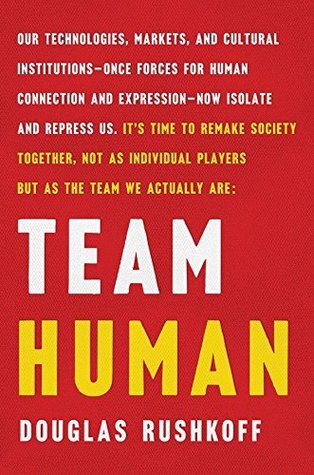More on this book
Community
Kindle Notes & Highlights
Autonomous technologies, runaway markets, and weaponized media seem to have overturned civil society, paralyzing our ability to think constructively, connect meaningfully, or act purposefully.
There’s a reason for our current predicament: an antihuman agenda embedded in our technology, our markets, and our major cultural institutions, from education and religion to civics and media. It has turned them from forces for human connection and expression into ones of isolation and repression.
The first step toward reversing our predicament is to recognize that being human is a team sport. We cannot be fully human alone.
Are you there? Yes, I hear you. You are not alone.
Our most advanced technologies are not enhancing our connectivity, but thwarting it. They are replacing and devaluing our humanity, and—in many different ways—undermining our respect for one another and ourselves.
Engineers at our leading tech firms and universities tend to see human beings as the problem and technology as the solution.
Social control is based on thwarting social contact and exploiting the resulting disorientation and despair.
Thinking, feeling, connected people undermine the institutions that would control them.
The most direct benefit of more neurons and connections in our brains is an increase in the size of the social networks we can form. Complicated brains make for more complex societies.
Our nervous systems learned to treat our social connections as existentially important—life or death. Threats to our relationships are processed by the same part of the brain that processes physical pain. Social losses, such as the death of a loved one, divorce, or expulsion from a social group, are experienced as acutely as a broken leg.
Humans are defined not by our superior hunting ability so much as by our capacity to communicate, trust, and share.
To have autonomy without interdependency leads to isolation or narcissism. To have interdependency with no autonomy stunts our psychological growth. Healthy people live in social groups that have learned to balance or, better, marry these two imperatives.
The World Wide Web was originally intended as an easier way to find and hyperlink research documents. But its visual, clickable interface felt a lot more like television than the rest of the net, and attracted the interest of marketers.
The platforms themselves were no longer in the business of delivering people to one another; they were in the business of delivering people to marketers. Humans were no longer the customers of social media. We were the product.
Transhumanists hope to transcend or at least improve upon biological existence. Some want to use technology to live forever, others to perform better, and still others to exit the body and find a better home for consciousness. Following through on mechanomorphism, transhumanism holds that people can be upgraded just like machines. By blurring the line between what we think of as biological and technological, transhumanists hope to ease our eventual, inevitable transition to life on a silicon chip.
To a hammer, everything is a nail. To an AI, everything is a computational challenge.
Art, at its best, mines the paradoxes that make humans human. It celebrates our ability to embrace ambiguity, and to experience this sustained, unresolved state as pleasurable, or at least significant.
Our uneasiness with simulations—whether they’re virtual reality, shopping malls, or social roles—is not something to be ignored, repressed, or medicated, but rather felt and expressed. These situations feel unreal and uncomfortable for good reasons. The importance of distinguishing between human values and false idols is at the heart of most religions, and is the starting place for social justice. The uncanny valley is our friend.
wettiko: a delusional belief that cannibalizing the life force of others is a logical and morally upright way to live.
Techno-utopians like to think of themselves as orchestrating a complete break from civilization—a leap into outer space, cyberspace, machine consciousness, or artificial life.
Computers and artificial intelligences are pure intention, not clouded or tempered by human social priorities or moral misgivings. They are a direct, utilitarian extension of our apocalyptic urge to colonize the natural world.
When the individual’s needs are balanced with those of the collective, things stay in balance.


